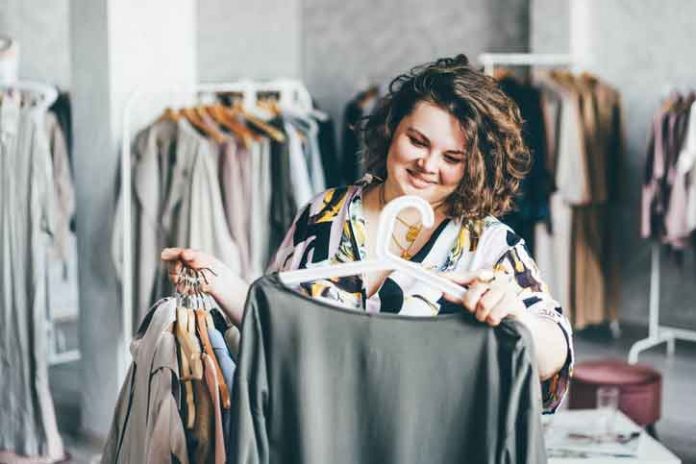Imagine you’re a woman trying on clothes in the dressing room. Suddenly the zipper won’t close. The jeans won’t fit. You feel yourself squeezing into articles of clothing more than simply gliding into them. Did you go to a plus-size Vero Moda section to only find clothes on the corner shelf in black colour? Did you sigh when your friends bought affordable clothes in the Sarojini market but you were left choiceless? “Sorry, we don’t have this in your size” is a common sentence for a chubby shopper.
The notion that plus-size fashion has been capitalised for profit by fashion brands isn’t new. We’ve spent decades staring at hourglass figures on the front cover of magazines, letting the entire beauty industry emotionally exploit our insecurity and packaging it into slimming capsules.
Did you know that most plus-size clothing isn’t seen on the glass displays out front? They’re not the first thing you’re going to see when you walk into a retail store. Hell, you might not even see them unless you ask. These extra slabs of fabric are kept in the corner in stores, away from prying eyes. Many women find it very uncomfortable to ask the store workers about the “plus-size” clothes section. They feel marginalised from the direct gaze of shoppers and workers when they mention the size after years of normalising only one standard of beauty.
There is less accessibility of more oversized clothes in the market and mostly limited to urbanscapes. The cost of buying clothes in a larger size is more than smaller ones. So, where do the lower-class, caste and differently-abled plus size women lie in the capitalist structure?
Selling Empowerment: The New Femvertising?
Feminist has, for better and worse, become a buzzword. It is perhaps the token descriptor of our time. Feminism has emancipated from its clearly political and economic origins and took a drastic turn – for the better or worse remains debatable. A feminist is no longer a bra averse radical that spouts Marxist ideals and pushes for specific socio-economic and political change. Instead, feminism has been rebranded for the general public’s consumption. It is now an institution that is trendy and current. It is a movement led by Emma Watson and her ilk speaks in a younger, whiter voice and says, “Yes queen!”.
Its name is often reduced to the stomachable ‘girl power.’ Its vague new mission of self-empowerment and its glamorous new face in the form of Beyonce has been seized upon by marketing teams and design teams in the fashion industry. In 2007, Dolce and Gabbana’s campaign advertisement featured the eroticisation of violence against women. Today, however, the tone is different: advertisements depict powerful images of plus-size models staring resolutely into a camera, donned in graphic t-shirts that directly reference feminist theory. Brands cannot capitalise on the male gaze without backlash or boycott threats anymore. Sexism no longer has the same selling power. Unfortunately, it has been replaced by feminism.
Now, feminism has become the capitalisation of feminist ideals and morale. It’s become so intertwined that one cannot exist without the other. Feminism and capitalism now go hand-in-hand, with the leftist ideology emphasising that capitalism only accelerates the inequalities in the system. Their feminism extends not to political action or economic involvement but instead remains rooted in the inherently flawed idea that shopping can replace political action.
So Why Is The Phrase ‘Plus Size Models’ Problematic?
The modelling industry, in particular, has a long history of blurring the lines between what constitutes as modern-day feminism. Many clothing brands and fashion magazines have attempted to launch campaigns that cater to models who are at the peripheries of “ideal beauty”, or in layman’s terms called “plus-size models.” In a bid to expand their marketability and social appeal, many of these brands hire models who are chubby, plump or ‘not skinny enough’ to fit into boxed perceptions of what is beautiful—to keep up an appearance that supposedly understands subjective ideas of beauty.
While the idea of “credit where credit is due” can be applied here, it’s not without fault. While it certainly is bold to challenge a brick-and-mortar industry by hiring plus-size models, it begs the question, is that genuinely empowering for the women they hire or for the women who view them on magazine covers, TV shows and brand advertisements?
To actual plus-size models who live and work in a body society has told them aren’t fit for even existing, it can certainly come across as more of a tokenship than an actual allyship. It’s a somewhat transparent attempt to publicise inclusivity, while simultaneously depreciating its value by making the fact they are “plus size” all there is to them. It disempowers women by strengthening the already existing segregation between women of size, and women who fit into the ideal standards of beauty.
It creates a fissure between bodies that are acceptable in the modelling and fashion industries and bodies that seemingly aren’t. The phrase de-normalises women who don’t have “size zero” figures and normalises women who do, by placing women in the latter category on a pedestal. It also attributes a discriminatory monopoly to women who embody the “size zero” classification within the industry.
There have been many false attempts at empowering women of all sizes are being made, but women who don’t fit into the patriarchal template of the ideal body type are still alienated from the discourse that promotes clothes that are body-hugging, short, strappy and seemingly more flattering than the ones currently being advocated for them. It’s as if society’s anxieties about plump women exposing themselves are being mirrored in the attempts being made by these brands, subtly telling women what they can or cannot wear. It feels like a compensatory effort, to make women with varying body types feel like they’re part of the sample size status quo, when in reality, they are at the threshold of marginalisation.
The notion that the modelling industry aims to diversify the kind of models they have by hiring “plus-size models” becomes counterintuitive. And in their bid to do so, they are alienating many other intersections of women like women of colour, different races, abilities and special abilities, sizes etc. Moreover, even in their definition of “plus-size”, this industry expects women to fit into a certain template of what construes the ideal kind of “plus-size”, usually focussing on thick thighs and big boobs, with a relatively thinner waist. Here, voluptuous women embody the idea of being “plus-size”.
Should Capitalistic Feminism Be Stopped?
The first time anyone even heard the term ‘feminist’ was during the industrial revolution for the pursuit of economic agency of the woman. From women wearing pants in the 20th CE to the women demanding pockets today, capitalism and feminism have interconnected many times. Plus-size fashion indeed needs to be marketed and made widely accessible to the people.
In the concentric circle of power relations, someone needs to stand in the centre and uplift those standing at the corners of society. Although polished curvy models have been marketed more, it has given feminism and body positivity a chance of expression never before seen. Now it is required to move the women of larger bodies of different shapes, communities and spaces to the centre.
Fashion acts both as a personal and socio-political statement. It leads to the creation of identities and formulates the independent agency. Hoping for a brighter future with more inclusive and abundant choices in plus-size fashion isn’t exactly asking for the world.



































